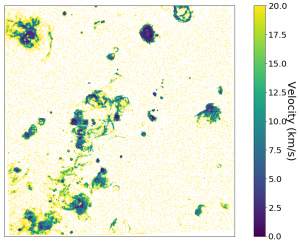SITELLE Machine Learning
Machine learning, a new technology revolutionizing the analysis of large data sets, has gained traction in the astronomical community for the past decade. A team of researchers led by Carter Rhea from the Université de Montréal and Laurie Rousseau-Nepton of the Canada-France-Hawaii Telescope are spearheading efforts to bring machine learning into the flow of SITELLE data analysis. In the first paper of the series, the team shares their application of a convolutional neural network to SITELLE spectra to estimate kinematic parameters.

Residual map of the recovered velocity parameter in the Southwest field of M33. The residual was calculated by taking the difference between the network's estimate and that of the ORCS fitting software.
SITELLE, the CFHT’s unique imaging Fourier Transform Spectrograph, is capable of generating 3D data cubes containing more than 4 million spatial pixels and a spectral resolving power of 10,000 resulting in a total of over 40 billion spectral pixels or spaxels. Analysis on this volume of data requires a dedicated suite of tools designed specifically for SITELLE by Thomas Martin, astronomer at the Université Laval. The ORCS (Outils de Réduction de Cubes Spectraux) software package was designed precisely for this reason; using ORCS, an astronomer can fit each spectrum in the data cube. SITELLE measures the amount of light, or photons, that hits each pixel during the exposure. ORCS “fits” those photon counts into a scientifically usable spectrum, enabling astronomers to learn about the complex physics in planetary nebulae and HII regions.
Before fitting a spectrum, ORCS requires the user to input an initial estimate for the velocity and broadening parameters. Astronomers rely on previous studies of their objects to determine these initial estimates. However, these estimates frequently come from older, potentially outdated, research which may not be appropriate or available for all nebulae. An inaccurate initial estimate triggers a series of unsound calculations ultimately leading to an incorrect solution. Prior to the team’s works, SITELLE users did not have a standard method for determining initial estimate values.
“When we started this project, we were hoping to capitalize on recent successes employing a machine learning technique known as a convolutional neural network to calculate spectral parameters,” says Simon Prunet, CFHT resident astronomer. “Convolutional neural networks are becoming increasingly common in the field of image processing including recent success in astronomy.”
These networks take spectrum and break them down into their most important components, learning to extract key parameters from the input. Convolutional neural networks are trained with labeled data through a process known as supervised learning where the networks learn to associate patterns in the input images with corresponding output parameters. The networks are trained on pre-labeled data until they properly categorize inputs based on their labels. In the case of SITELLE , the team trained their algorithm on a suite of synthetic spectra specifically tailored to mimic actual data from the instrument. The synthetic data were generated using preexisting tools in another custom designed SITELLE software package, ORBS (Outils de Réduction Binoculaire pour SITELLE). After training the algorithm, it was extensively tested on freshly generated synthetic spectrum. Once the algorithm demonstrated its capability of accurately estimating the velocity and broadening parameters of emission-lines in SITELLE spectra, the team progressed their testing to include real observations taken by SITELLE. The network was applied to a SITELLE field from the galaxy M33. The team selected M33, a spiral galaxy hosting an assortment of emission-line nebulae, supernovae remnants, and planetary nebulae, due to M33’s, well established velocity and line broadening input estimates. The results indicate that the network recovers the broadening and velocity values with errors similar to those found by ORCS.
“This type of analysis is a game-changer for astronomers using SITELLE,” says Laurie Rousseau-Nepton, CFHT resident astronomer and SITELLE instrument scientist. “The network analyzes the data in a fraction of the time previously required, greatly speeding up the time it takes to reduce the enormous amounts of data generated by projects like our large program SIGNALS.”
Carter Rhea, the machine learning project’s lead and graduate student at Université de Montréal , notes that “This is the beginning of what we can do with machine learning to revolutionize data analysis from instruments such as SITELLE. It is incredibly exciting for me to work on the intersection of machine learning and astronomical data sets.”
Source: Canada-France-Hawaii Telescope
- 335 reads



